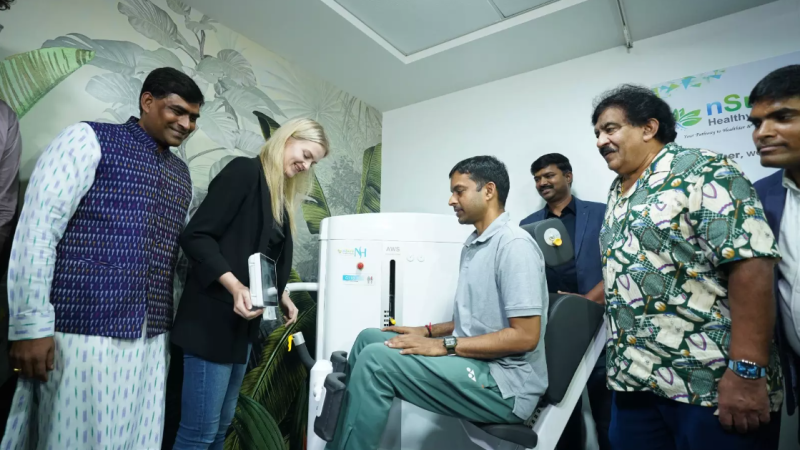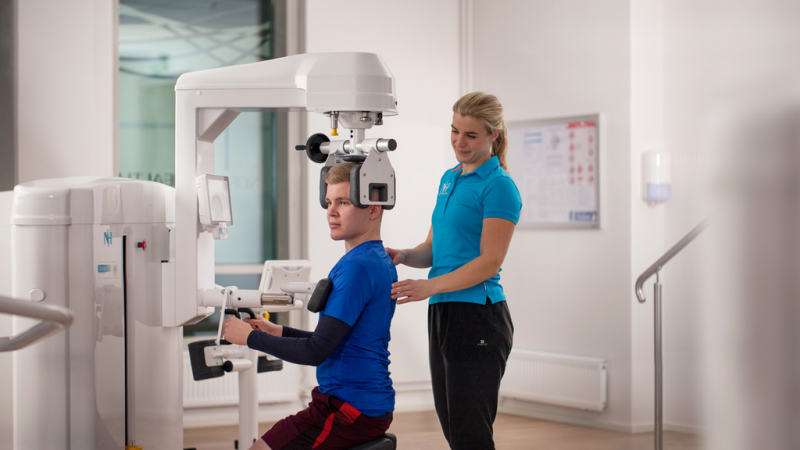Inactivity kills, or at least makes you older
The consequences of inactivity are grave, often accelerating the aging process. Many of us have firsthand experience with the tangible effects of aging, witnessing declines in both physical and mental capacities. Yet, lurking beneath the surface, there’s a clandestine accumulation of risks that may one day erupt dramatically. For some, this serves as a wake-up call to embrace radical lifestyle changes, while for others, it may sadly be too late. What’s less commonly known is that, in addition to the typical cardiovascular issues associated with a sedentary lifestyle, our passive habits and poor dietary choices pave the way for a host of other diseases, including cancer, diabetes, osteoarthritis, and osteoporosis, among others. Even for those who prioritize mental well-being over physical health, the loss of muscle mass causes a concerning parallel decline in cognitive capacity (1). This interconnectedness between body and mind is increasingly recognized, echoing the sentiments of the ancient Roman poet Juvenal, who famously proclaimed, «mens sana in corpore sano»: a healthy mind in a healthy body.

Fig, 1 The World is suffering from a multitude of lifestyle-induced diseases
Fighting lifestyle-induced diseases?
In the battle against lifestyle-induced diseases, we’re familiar with the list of dos and don’ts for maintaining health:
- eat nutritious foods
- exercise regularly
- prioritize sleep
- manage stress
- foster social connections cultivate a positive mindset
These guidelines are widely acknowledged as beneficial and should be adhered to. However, many of us may not fully comprehend the practical implications of these actions or their effectiveness. Moreover, there is often no immediate gratification, requiring sustained motivation based on faith until tangible benefits are felt. Conversely, unhealthy habits often provide instant satisfaction, making them difficult to resist. Amidst these challenges, there is one activity that stands out for its exceptional effectiveness and substantial scientific backing: resistance training.
The next blockbuster drug Exerkines
Described as the potential «next blockbuster drug,» the health benefits derived from resistance training are garnering increasing attention. As scientific knowledge expands, researchers continue to identify a growing number of molecules excreted by various body parts during resistance training. Coined as «Exerkines,» these molecules encompass a diverse array, including proteins, myokines, cytokines, neurotransmitters, and hormones. Figure 2 illustrates examples of exerkines released post-exercise, each playing a crucial role in bodily functions such as repairing tissues, enhancing immunity, regulating cell growth, and facilitating nerve generation. These molecules are instrumental in supporting overall health and well-being.
Given the broad impact of exerkines on various organs and bodily functions, further exploration into specific areas of research is warranted.
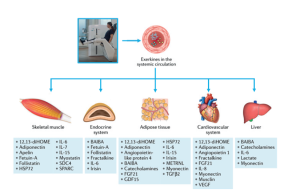
Fig, 2 Exerkines released after exercise into the systemic circulation (2)
Health benefits with no side effects
An obvious benefit for an aging person lies in improved functional capacity. Muscle strength, endurance, coordination, and the ability to manage everyday life are all enhanced, improving quality of life and increasing the ability to participate in various activities. As a bonus, this also reduces pain in the back, knees, and shoulders, issues many people suffer from without reason.
However, the benefits extend to diverse areas not seemingly connected to exercise. Take, for example, depression. A recent study found that exercise can be as effective as therapy or depression medication (3). Many similar studies support this notion, making it something everyone can try relatively quickly. The endorphins produced during exercise provide the instant gratification we discussed earlier.
Type 2 Diabetes is a modern-day curse affecting millions of people, with an equal number of undiagnosed prediabetes sufferers likely to develop the disease in a few years. However, several studies show that resistance training can both prevent type 2 diabetes and play an important role in its treatment (4).
Similarly, the role of exercise in combating cancer cannot be overstated. While cancer treatments have advanced significantly, they often come with unpleasant side effects and weaken patients. Exercise has emerged as a powerful tool in both prevention and treatment, addressing dysregulated metabolism—a common feature of cancer. By improving insulin sensitivity, reducing inflammation, and enhancing muscle mass and strength, exercise offers acute and long-term metabolic benefits (5).
Furthermore, resistance training has been shown to significantly improve the well-being of cancer patients, reducing nausea, acid reflux, fatigue, and appetite loss during chemotherapy (6).
Perhaps the most amazing outcome of resistance training is its effect on the brain. While one might think there is little connection between the brain and muscles, science speaks of muscle-brain crosstalk (7). Resistance training has been found to improve the brain›s executive functions and even create more white matter. Although both aerobic and resistance training are valuable, the superiority of resistance training is evident in various health outcomes, including all-cause mortality, diabetes, cancer, and frailty. Its holistic benefits make it an essential component of any comprehensive exercise regimen.
Maximizing training effectiveness
Not all training methods are created equal. While activities like walking and gardening offer benefits, the most significant gains come from high-intensity resistance training. Studies show that higher intensity levels are necessary for the secretion of certain molecules essential for health (8).
This leads us to the question of which exercise per unit of time is most effective, especially for aging individuals. At David Health Solutions, we have been working for decades to improve both the efficiency of exercise and individual motivation. Based on this experience, we can identify three main factors that influence the effectiveness of training:
- The requirement for coordination in training
- The effect of the resistance curve in the exercise
- Motivation to train with higher intensity
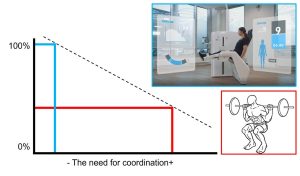
Fig, 3 The relationship between the need for coordination and safety
While all exercises demand a certain level of coordination, some are inherently riskier and require greater care and lower loading to ensure safety. For instance, the squat movement, while effective, poses risks with heavier loads. Conversely, a well-designed knee extension device offers a safe option, allowing for high-intensity training without risk. To encourage large populations to engage in high-intensity training, it is crucial to provide safe tools. Figure 3 illustrates how the need for coordination is inversely correlated with intensity.
All exercises inherently involve variable resistance in relation to joint angle, either intentionally or inadvertently. However, many people are unaware of the ideal loading curve for each exercise. In a properly designed device, the loading curve aligns with the biomechanical strength curve of the joint. Unfortunately, this alignment is rarely achieved. Most exercises and devices offer an incorrect loading curve, resulting in discomfort during the exercise and, more importantly, ineffective training outcomes. Figure 3 illustrates two exercises: one correctly matching the strength curve and one incorrectly designed, such as a pulley system where the heaviest load is at the point where muscles are weakest.
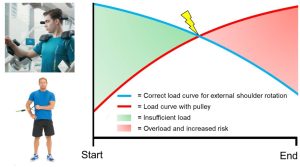
Fig, 4 The difference between correct and incorrect loading curves
Correct loading significantly impacts training results by providing even loading throughout the movement and inducing a substantial fatiguing effect (9). Research has compared this effect to other loading types, such as pneumatic loading (10). Gravity-based loading with the correct loading curve has proven to be the most effective method for inducing necessary muscle fatigue safely.
Regardless of the training method, the most important aspect is to ensure that individuals train consistently. This involves educating them about the considerable benefits of regular resistance training. Additionally, creating a motivating environment where technology offers continuous feedback on each training session and periodic testing provides results of the benefits is crucial. Figure 4 demonstrates how a motivational screen can display the appropriate range of motion, speed, and repetition count. When results are immediately visible, people tend to complete the exercise even when muscles are fatigued, especially knowing that trainers can access the results from their computers at any time. It is no wonder that centers using this system show compliance levels of over 90%, indicating that virtually everyone correctly completes their planned sets.

Fig. 5 The Interactive screen helps the user to train at the right intensity level correctly and safely. After the training, an immediate result shows how well the exercise was performed, which is very empowering and motivating.
Exercise is undeniably a miracle cure, offering countless benefits for both physical and mental health. However, the question remains: will these benefits reach those who need them most? Many aging individuals, who are inactive and lack experience in training, may feel too intimidated to join regular gyms. This presents both a challenge and a significant opportunity.
Fitness centers, wellness centers, and even medical facilities have the chance to design environments that cater to the needs of these individuals, providing them with a sense of safety, professional guidance, and access to effective, user-friendly technology for training. Experience has shown that age should not be a limiting factor; individuals can begin their fitness journey at any age, whether they are 50 or 80 years old.
In the next five years, we anticipate substantial growth in this market. This growth will not only bring happiness to individuals by improving their health and well-being but also contribute to happier societies overall, with a growing population that is less of a burden on healthcare systems.
- Uchida et al., ‘Association between Reduction of Muscle Mass and Faster Declines in Global Cognition among Older People’.
- Chow et al., ‘Exerkines in Health, Resilience and Disease’.
- Recchia et al., ‘Comparative Effectiveness of Exercise, Antidepressants and Their Combination in Treating Non-Severe Depression’.
- Codella et al., ‘May the Force Be with You’.
- Raun et al., ‘Exercise—A Panacea of Metabolic Dysregulation in Cancer’.
- Hong, Wu, and Wu, ‘Effects of Resistance Exercise on Symptoms, Physical Function, and Quality of Life in Gastrointestinal Cancer Patients Undergoing Chemotherapy’.
- Delezie and Handschin, ‘Endocrine Crosstalk Between Skeletal Muscle and the Brain’.
- Schwarz et al., ‘Effect of Resistance Exercise Intensity on the Expression of PGC-1α Isoforms and the Anabolic and Catabolic Signaling Mediators, IGF-1 and Myostatin, in Human Skeletal Muscle’.
- Hakkinen and Kauhanen, ‘Effects of Fatiguing Loading with a Variable Resistance Equipment on Neural Activation and Force Production of the Knee Extensor Muscles’.
- Peltonen, Häkkinen, and Avela, ‘Neuromuscular Responses to Different Resistance Loading Protocols Using Pneumatic and Weight Stack Devices’.
 English
English 






















